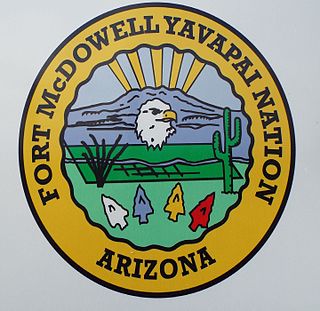
The Cocopah are Native Americans who live in Baja California, Mexico, and Arizona, United States.

The Quechan are an aboriginal American tribe who live on the Fort Yuma Indian Reservation on the lower Colorado River in Arizona and California just north of the Mexican border. Despite their name, they are not related to the Quechua people of the Andes. Members are enrolled into the Quechan Tribe of the Fort Yuma Indian Reservation. The federally recognized Quechan tribe's main office is located in Winterhaven, California. Its operations and the majority of its reservation land are located in California, United States.

The Fort Mohave Indian Reservation is an Indian reservation along the Colorado River, currently encompassing 23,669 acres (95.79 km2) in Arizona, 12,633 acres (51.12 km2) in California, and 5,582 acres (22.59 km2) in Nevada. The reservation is home to approximately 1,100 members of the federally recognized Fort Mojave Indian Tribe of Arizona, California, and Nevada, a federally recognized tribe of Mohave people.

The San Xavier Indian Reservation is an Indian reservation of the Tohono O’odham Nation located near Tucson, Arizona, in the Sonoran Desert. The San Xavier Reservation lies in the southwestern part of the Tucson metropolitan area and consists of 111.543 sq mi (288.895 km²) of land area, about 2.5 percent of the Tohono O’odham Nation. It had a 2000 census resident population of 2,053 persons, or 19 percent of the Tohono O’odham population.
Native Americans have inhabited what is now Arizona for thousands of years. It remains a state with one of the largest percentages of Native Americans in the United States, and has the second largest total Native American population of any state. In addition, the majority of the Navajo Nation, the largest Native American reservation in the US, and the entire Tohono O'odham Nation, the second largest, are located in Arizona. Over a quarter of the area of the state is reservation land.

The Yavapai–Apache Nation is a federally recognized Native American tribe in Verde Valley, Arizona. Tribal members share two culturally distinct backgrounds and speak two indigenous languages, the Yavapai language and the Western Apache language. The Yavapai–Apache Nation Indian Reservation, at 34°37′10″N111°53′46″W, consists of five non-contiguous parcels of land located in three separate communities in eastern Yavapai County. The two largest sections, 576 acres (233 ha) together – almost 90 percent of the reservation's territory, are in the town of Camp Verde. Smaller sections are located in the town of Clarkdale 60.17 acres (24.35 ha), and the unincorporated community of Lake Montezuma. The reservation's total land area is 642 acres (260 ha). The total resident population of the reservation was 743 persons as of the 2000 census. The 2010 Census reported 1,615 people on the reservation. Of these, 512 lived in Camp Verde, 218 in Clarkdale, and only 13 in Lake Montezuma.
The Agua Caliente Band of Cahuilla Indians of the Agua Caliente Indian Reservation is a federally recognized tribe of the Cahuilla, located in Riverside County, California. They inhabited the Coachella Valley desert and surrounding mountains between 5000 BCE and 500 CE. With the establishment of the reservations, the Cahuilla were officially divided into 10 sovereign nations, including the Agua Caliente Band.

The Fort Apache Indian Reservation is an Indian reservation in northeastern Arizona, United States, encompassing parts of Navajo, Gila, and Apache counties. It is home to the federally recognized White Mountain Apache Tribe of the Fort Apache Reservation, a Western Apache tribe. It has a land area of 1.6 million acres and a population of 12,429 people as of the 2000 census. The largest community is in Whiteriver.

The Colorado River Indian Tribes is a federally recognized tribe consisting of the four distinct ethnic groups associated with the Colorado River Indian Reservation: Chemehuevi, the Mohave, Hopi, and Navajo. The tribe has about 4,277 enrolled members. A total population of 9,485 currently resides within the tribal reservation according to the 2012-2016 American Community Survey data.

The Cocopah Indian Reservation is the reservation of the federally recognized Cocopah Indian Tribe, which represents Cocopah peoples in the United States. As of the 2000 census a resident population of 1,025 persons, of whom 519 were solely of Native American heritage, lived on the 25.948 km2 (10.019 sq mi) Cocopah Indian Reservation, which is composed of three non-contiguous sections in Yuma County, Arizona, lying northwest, southwest and south of the city of Yuma, Arizona. The larger section, bordering the Colorado River, lies west of the Yuma suburb of Somerton, while the other section lies just east of Somerton.
The Quoeech were a Native American group who lived in southern Nevada. When missionaries of The Church of Jesus Christ of Latter-day Saints first went to Las Vegas in 1855 they were contacted by Quoeech who lived at some distance from Las Vegas. Some of the Quoeech were later baptized. They were also known as the Diggers.

The Yuma County Area Transit (YCAT) system is a public transportation system based in Yuma County, Arizona. Since 1990 the agency has grown from a new transit service offering paratransit to the current mix of fixed-route and demand-responsive services serving over 32,000 riders per month, with an annual operating budget of $2.5 million. YCAT is also the local Greyhound Lines agent.
Imperial Valley Transit (IVT), also known as IV Transit, is the provider of mass transportation in California's Imperial Valley, serving the cities of El Centro, Calexico, Brawley, and Imperial. Formed in 1989 with just 3 buses and serving close to 3000 passengers per month, the agency currently serves more than 73,000 passengers per month with over 20 buses in operation. Twelve routes, plus the El Centro Circulators form the structure of the system. Service is provided every day of the week except on recognized federal holidays. Two limited stop routes also travel Monday-Saturday, and two express buses run to Imperial Valley College when classes are in session.

Paradise Casino is a small tribal casino located just outside of Yuma, Arizona on the Fort Yuma Indian Reservation. The property straddles the Arizona–California state line, but the casino building lies in Arizona. It is owned and operated by the Quechan Tribe of the Fort Yuma Indian Reservation.

The Yuma War was the name given to a series of United States military operations conducted in southern California and what is today southwestern Arizona from 1850 to 1853. The Quechan were the primary opponent of the United States Army, though engagements were fought between the Americans and other native groups in the region.

The Fort McDowell Yavapai Nation, formerly the Fort McDowell Mohave-Apache Community of the Fort McDowell Indian Reservation, is a federally recognized tribe and Indian reservation in Maricopa County, Arizona about 23 miles (37 km) northeast of Phoenix.
Jaeger City, or Jaegerville, was a former settlement in what is now Imperial County, California, at Jaeger's Ferry on the Colorado River a mile downstream from Fort Yuma. It was named for L. J. F. Jaeger who ran the ferry there from 1851.
Orange Grove Mobile Manor is a census-designated place (CDP) and colonia in Yuma County, Arizona, United States. The population was 555 at the 2010 census. It is part of the Yuma Metropolitan Statistical Area.
Drysdale is a census-designated place (CDP) in Yuma County, Arizona, United States. The population was 272 at the 2010 census.
Claudette Christine White was an American Chief Judge for the Quechan Tribal Indian Court from 2006 to 2020 and for the San Manuel Band of Mission Indians from 2018 to 2020.















